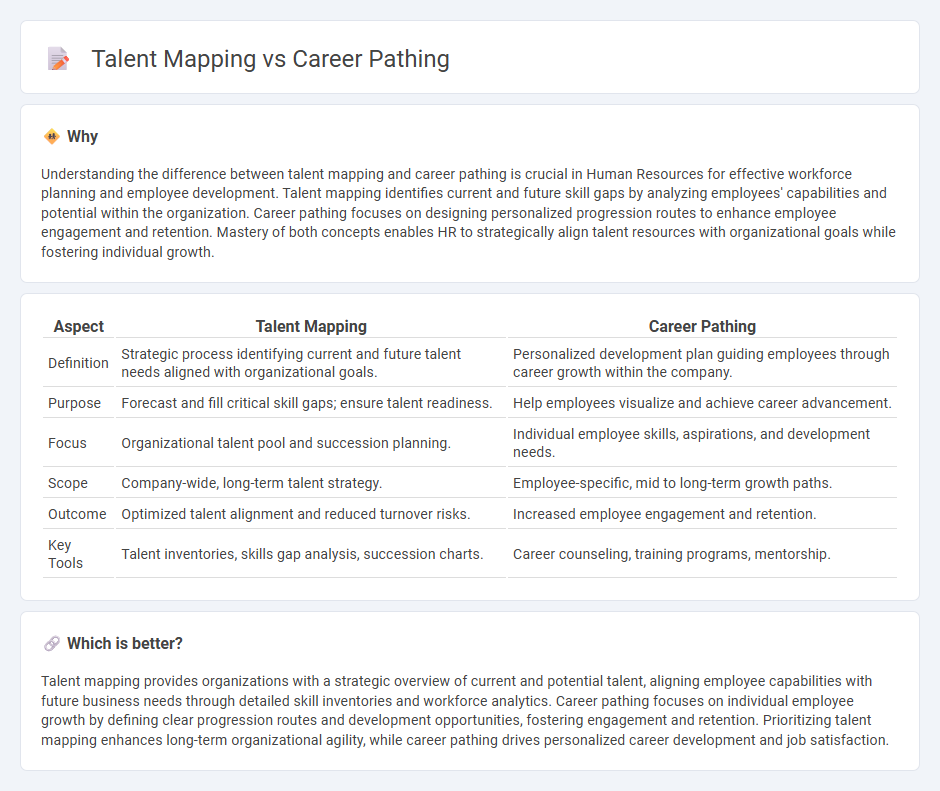
Talent mapping focuses on identifying and analyzing the skills, potential, and availability of internal and external candidates to meet organizational needs effectively. Career pathing emphasizes guiding employees through structured development plans to achieve long-term career goals aligned with company objectives. Explore more to understand how these strategies enhance workforce planning and employee engagement.
Why it is important
Understanding the difference between talent mapping and career pathing is crucial in Human Resources for effective workforce planning and employee development. Talent mapping identifies current and future skill gaps by analyzing employees' capabilities and potential within the organization. Career pathing focuses on designing personalized progression routes to enhance employee engagement and retention. Mastery of both concepts enables HR to strategically align talent resources with organizational goals while fostering individual growth.
Comparison Table
| Aspect | Talent Mapping | Career Pathing |
|---|---|---|
| Definition | Strategic process identifying current and future talent needs aligned with organizational goals. | Personalized development plan guiding employees through career growth within the company. |
| Purpose | Forecast and fill critical skill gaps; ensure talent readiness. | Help employees visualize and achieve career advancement. |
| Focus | Organizational talent pool and succession planning. | Individual employee skills, aspirations, and development needs. |
| Scope | Company-wide, long-term talent strategy. | Employee-specific, mid to long-term growth paths. |
| Outcome | Optimized talent alignment and reduced turnover risks. | Increased employee engagement and retention. |
| Key Tools | Talent inventories, skills gap analysis, succession charts. | Career counseling, training programs, mentorship. |
Which is better?
Talent mapping provides organizations with a strategic overview of current and potential talent, aligning employee capabilities with future business needs through detailed skill inventories and workforce analytics. Career pathing focuses on individual employee growth by defining clear progression routes and development opportunities, fostering engagement and retention. Prioritizing talent mapping enhances long-term organizational agility, while career pathing drives personalized career development and job satisfaction.
Connection
Talent mapping identifies current employees' skills and potential, providing a data-driven foundation for effective career pathing within organizations. Career pathing leverages this information to create personalized growth trajectories that align employee development with organizational goals. Together, these strategies enhance workforce planning, improve retention, and ensure talent readiness for future leadership roles.
Key Terms
Career pathing:
Career pathing centers on outlining personalized growth trajectories within an organization, helping employees identify skills, experiences, and roles aligned with long-term career goals. This approach drives employee engagement, retention, and development by providing clear milestones and progression opportunities tailored to individual aspirations. Explore how effective career pathing can enhance workforce planning and empowerment by learning more.
Succession Planning
Career pathing aligns employee growth with organizational goals by outlining potential roles and skills development within a company, enhancing retention and engagement. Talent mapping identifies high-potential individuals and critical roles to ensure leadership continuity and risk mitigation in succession planning. Explore deeper insights into how these strategies drive effective succession planning and workforce development.
Skill Development
Career pathing emphasizes individual skill development by identifying roles aligned with personal growth and competencies, fostering continuous learning and advancement within an organization. Talent mapping involves analyzing workforce skills at a macro level to anticipate future needs and strategically allocate resources for skill enhancement across teams. Explore more to understand how integrating both approaches can optimize employee potential and organizational success.
Source and External Links
What Is Career Pathing & Why Is It Important? - Paychex - Career pathing is the process employers use to create a customized plan and development track helping employees see how their skills and interests align with career goals, outlining possible roles and steps for growth or transition within or beyond the organization.
Definition of Career Pathing - Gartner Human Resources Glossary - Career pathing aligns employee career growth opportunities with organizational talent priorities, mapping vertical, lateral, or cross-functional roles based on skills, interests, and objectives to encourage learning and development.
Career Pathing: The Complete Guide - Qualtrics - Career pathing involves planning and setting goals using either a traditional career ladder with linear promotions or a career lattice allowing lateral moves and exploration of new roles within a flat organizational structure.
 dowidth.com
dowidth.com